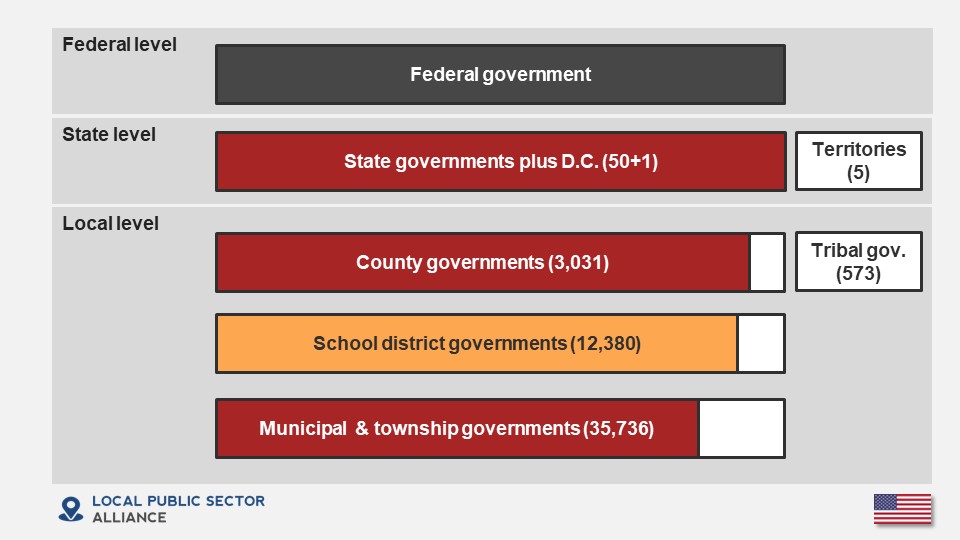
The United States of America, commonly known as the United States, is a federal country primarily located in North America. It consists of 50 states, a federal capital district, and five major unincorporated territories. Most Americans have more frequent contact with their state and local governments than with the federal government. Schools, libraries, police and fire departments, housing services, parks and recreation services, emergency medical services, municipal courts, public transportation, streets, and other public works usually fall under the responsibility of state and local governments. Subnational government officials in the United States are generally highly empowered to respond to the needs and priorities of their constituents across all levels of the multilevel governance system.
Subnational governance structure
The United States is a federal country comprised of three levels of government: federal, state, and local. The U.S. Constitution provides the overarching framework for federal-state relations, while state-local government relations in the U.S. are governed by the state constitution and state-level legislation in each state. States represent the primary territorial-administrative subdivision of the United States. In turn, states are subdivided into counties or county-equivalent units. The third territorial-administrative level of the United States is formed by subcounty local governments, consisting of municipalities and township governments. The local government structure further includes elected school district governments and other special-purpose local government entities.
Nature of subnational governance institutions
State governments, county governments, and municipal and township governments should be considered devolved subnational government institutions with extensive powers and functional responsibilities. Independent school district governments with elected school boards—as well as other elected special purpose governments in the United States with their own taxation powers—should generally be considered devolved local government institutions with limited functional responsibilities.
Functional assignments
Even though the subsidiarity principle is not formally established in the U.S. Constitution, there is a clear recognition in American federalism of the principles of states’ rights and local self-governance. As a result, most frontline public services are delivered by state and local governments at the lowest government level that can deliver the relevant services efficiently.
This does not mean that state and local governments ‘go it alone’. Federal and state policy objectives are frequently pursued by ensuring stronger, more coordinated, and better funded partnerships among federal, state, and local governments. As a result, the American multilevel governance system is commonly referred to as “marble cake federalism” as responsibilities for policy setting, financing, administering, and delivering public services are commonly shared among different levels of government.
LoGICA Score Card
State and local government officials in the United States are highly empowered to respond to the needs and priorities of their constituents. When the multilevel governance system in the United States is assessed using the LoGICA Score Card, the resulting LoGICA Scorecard Total is 93.5 points (out of 100), scoring high across all five dimensions of multilevel governance.
LoGICA Assessments
LoGICA Intergovernmental Profile: USA 2022 (PDF / Excel)
Additional resources
Local Government Autonomy in the United States of America (Boex and Wolman, 2021)
United States of America Country Profile (World Observatory on Subnational Governance and Investment, OECD/UCLG)
Local government country profile: United States of America (UN Women)
United States of America: Country Profile (Forum of Federations)
Back to Local Public Sector Alliance Intergovernmental Profiles – Country Page
Last updated: September 24, 2023


